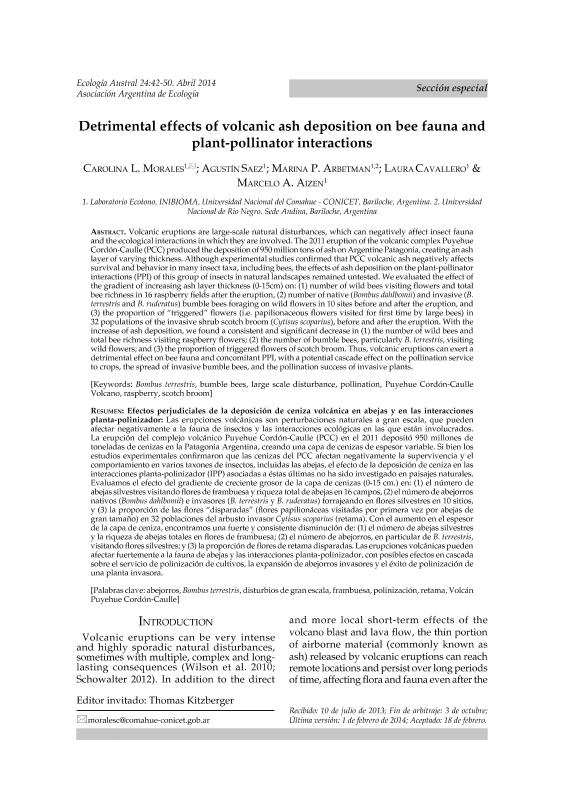Mostrar el registro sencillo del ítem
dc.contributor.author
Morales, Carolina Laura

dc.contributor.author
Sáez, Agustín

dc.contributor.author
Arbetman, Marina P.
dc.contributor.author
Cavallero, Laura

dc.contributor.author
Aizen, Marcelo Adrian

dc.date.available
2017-01-27T21:10:49Z
dc.date.issued
2014-04
dc.identifier.citation
Morales, Carolina Laura; Sáez, Agustín; Arbetman, Marina P.; Cavallero, Laura; Aizen, Marcelo Adrian; Detrimental effects of volcanic ash deposition on bee fauna and plant-pollinator interactions; Asociación Argentina de Ecología; Ecología Austral; 24; 1; 4-2014; 42-50
dc.identifier.issn
1667-782X
dc.identifier.uri
http://hdl.handle.net/11336/12137
dc.description.abstract
Volcanic eruptions are large-scale natural disturbances, which can negatively affect insect fauna and the ecological interactions in which they are involved. The 2011 eruption of the volcanic complex Puyehue Cordón-Caulle (PCC) produced the deposition of 950 million tons of ash on Argentine Patagonia, creating an ash layer of varying thickness. Although experimental studies confirmed that PCC volcanic ash negatively affects survival and behavior in many insect taxa, including bees, the effects of ash deposition on the plant-pollinator interactions (PPI) of this group of insects in natural landscapes remained untested. We evaluated the effect of the gradient of increasing ash layer thickness (0-15cm) on: (1) number of wild bees visiting flowers and total bee richness in 16 raspberry fields after the eruption, (2) number of native (Bombus dahlbomii) and invasive (B. terrestris and B. ruderatus) bumble bees foraging on wild flowers in 10 sites before and after the eruption, and (3) the proportion of “triggered” flowers (i.e. papilionaceous flowers visited for first time by large bees) in 32 populations of the invasive shrub scotch broom (Cytisus scoparius), before and after the eruption. With the increase of ash deposition, we found a consistent and significant decrease in (1) the number of wild bees and total bee richness visiting raspberry flowers; (2) the number of bumble bees, particularly B. terrestris, visiting wild flowers; and (3) the proportion of triggered flowers of scotch broom. Thus, volcanic eruptions can exert a detrimental effect on bee fauna and concomitant PPI, with a potential cascade effect on the pollination service to crops, the spread of invasive bumble bees, and the pollination success of invasive plants.
dc.description.abstract
Las erupciones volcánicas son perturbaciones naturales a gran escala, que pueden afectar negativamente a la fauna de insectos y las interacciones ecológicas en las que están involucrados. La erupción del complejo volcánico Puyehue Cordón-Caulle (PCC) en el 2011 depositó 950 millones de toneladas de cenizas en la Patagonia Argentina, creando una capa de cenizas de espesor variable. Si bien los estudios experimentales confirmaron que las cenizas del PCC afectan negativamente la supervivencia y el comportamiento en varios taxones de insectos, incluidas las abejas, el efecto de la deposición de ceniza en las interacciones planta-polinizador (IPP) asociadas a éstas últimas no ha sido investigado en paisajes naturales. Evaluamos el efecto del gradiente de creciente grosor de la capa de cenizas (0-15 cm.) en: (1) el número de abejas silvestres visitando flores de frambuesa y riqueza total de abejas en 16 campos, (2) el número de abejorros nativos (Bombus dahlbomii) e invasores (B. terrestris y B. ruderatus) forrajeando en flores silvestres en 10 sitios, y (3) la proporción de las flores “disparadas” (flores papilionáceas visitadas por primera vez por abejas de gran tamaño) en 32 poblaciones del arbusto invasor Cytisus scoparius (retama). Con el aumento en el espesor de la capa de ceniza, encontramos una fuerte y consistente disminución de: (1) el número de abejas silvestres y la riqueza de abejas totales en flores de frambuesa; (2) el número de abejorros, en particular de B. terrestris, visitando flores silvestres; y (3) la proporción de flores de retama disparadas. Las erupciones volcánicas pueden afectar fuertemente a la fauna de abejas y las interacciones planta-polinizador, con posibles efectos en cascada sobre el servicio de polinización de cultivos, la expansión de abejorros invasores y el éxito de polinización de una planta invasora.
dc.format
application/pdf
dc.language.iso
eng
dc.publisher
Asociación Argentina de Ecología

dc.rights
info:eu-repo/semantics/openAccess
dc.rights.uri
https://creativecommons.org/licenses/by-nc-sa/2.5/ar/
dc.subject
Bumble Bees
dc.subject
Large Scale Disturbance
dc.subject
Pollination
dc.subject
Puyehue Cordón-Caulle Volcano
dc.subject
Abejorros
dc.subject.classification
Ecología

dc.subject.classification
Ciencias Biológicas

dc.subject.classification
CIENCIAS NATURALES Y EXACTAS

dc.title
Detrimental effects of volcanic ash deposition on bee fauna and plant-pollinator interactions
dc.title
Efectos perjudiciales de la deposición de ceniza volcánica en abejas y en las interacciones planta-polinizador
dc.type
info:eu-repo/semantics/article
dc.type
info:ar-repo/semantics/artículo
dc.type
info:eu-repo/semantics/publishedVersion
dc.date.updated
2016-12-12T14:24:18Z
dc.identifier.eissn
0327-5477
dc.journal.volume
24
dc.journal.number
1
dc.journal.pagination
42-50
dc.journal.pais
Argentina

dc.journal.ciudad
Córdoba
dc.description.fil
Fil: Morales, Carolina Laura. Universidad Nacional del Comahue. Centro Regional Universitario Bariloche. Laboratorio de Ecotono; Argentina. Consejo Nacional de Investigaciones Científicas y Técnicas. Centro Científico Tecnológico Patagonia Norte. Instituto de Investigación en Biodiversidad y Medioambiente; Argentina
dc.description.fil
Fil: Sáez, Agustín. Universidad Nacional del Comahue. Centro Regional Universitario Bariloche. Laboratorio de Ecotono; Argentina. Consejo Nacional de Investigaciones Científicas y Técnicas. Centro Científico Tecnológico Patagonia Norte. Instituto de Investigación en Biodiversidad y Medioambiente; Argentina
dc.description.fil
Fil: Arbetman, Marina P.. Universidad Nacional del Comahue. Centro Regional Universitario Bariloche. Laboratorio de Ecotono; Argentina. Consejo Nacional de Investigaciones Científicas y Técnicas. Centro Científico Tecnológico Patagonia Norte. Instituto de Investigación en Biodiversidad y Medioambiente; Argentina. Universidad Nacional de Rio Negro. Sede Andina; Argentina
dc.description.fil
Fil: Cavallero, Laura. Universidad Nacional del Comahue. Centro Regional Universitario Bariloche. Laboratorio de Ecotono; Argentina. Consejo Nacional de Investigaciones Científicas y Técnicas. Centro Científico Tecnológico Patagonia Norte. Instituto de Investigación en Biodiversidad y Medioambiente; Argentina
dc.description.fil
Fil: Aizen, Marcelo Adrian. Universidad Nacional del Comahue. Centro Regional Universitario Bariloche. Laboratorio de Ecotono; Argentina. Consejo Nacional de Investigaciones Científicas y Técnicas. Centro Científico Tecnológico Patagonia Norte. Instituto de Investigación en Biodiversidad y Medioambiente; Argentina
dc.journal.title
Ecología Austral

dc.relation.alternativeid
info:eu-repo/semantics/altIdentifier/url/http://ojs.ecologiaaustral.com.ar/index.php/Ecologia_Austral/article/view/36
dc.relation.alternativeid
info:eu-repo/semantics/altIdentifier/url/http://ref.scielo.org/z79c5s
Archivos asociados
